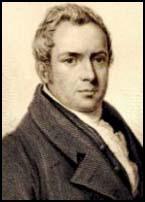William Hone

William Hone was born in Bath in 1780. William's family moved to London in 1783 and his father found work as a solicitor clerk. The family were devout Congregationalists and were regular attenders at the Weigh House Chapel. William was educated at the local dame school and at home by his father. One of the things that William's father taught him was that Congregationalists, like other religious dissenters, were persecuted by the Established Church. This sense of injustice was to remain with him for the rest of his life.
William developed radical political views at an early age and by the time he was sixteen he was attending meetings of the London Corresponding Society. When William joined the leaders of the group, Thomas Hardy, John Thelwall and John Horne Tooke had just been released from prison. William's father became concerned about his son's political friends and in an attempt to get him away from London found him a position as a solicitor's clerk in Chatham.
William Hone returned to London in 1800 where he married Sarah Johnson. By this time Hone had developed a passion for books and with financial help from his mother-in-law, he opened a book shop in Lambeth. Hone was more interested in buying books than selling them and within a couple of years his creditors had forced him out of business. Hone then went into business with Kidd Wake, a printer who had just served five years in jail for shouting 'No George, no war' during a demonstration against George III. This business also ended in bankruptcy.
Hone remained in contact with his radical friends and in 1810 was involved in the organisation of the reception given to Sir Francis Burdett after his release from the Tower of London. He also began publishing newspapers such as the Traveller and the Reformist Register. These ventures were unsuccessful and he then turned to publishing political pamphlets.
from left to right are William Jones, the publisher of The Scourge, George
Cruikshank, William Hone and George Cruikshank's brother, Robert.
William Hone began employing a talented young artist called George Cruikshank to illustrate his pamphlets. In 1815 the two men were shocked by the case of Elizabeth Fenning, a poor servant girl who had been sentenced to hang after being found guilty of poisoning her master and mistress. Hone and Cruikshank believed Fenning was innocent of the crime and produced a pamphlet entitled The Maid and the Magpie about the case. Hone wrote the text and Cruikshank provided the powerful drawings. The pamphlet did not save Elizabeth Fenning from the scaffold but it did provide Hone with his first bestseller.
Hone and Cruikshank continued to work together on a series of pamphlets. These often expressed radical ideas about politics and religion and in 1817 William Hone was arrested for publishing the Late John Wilkes's Catechism, The Sinecurist's Creed and The Political Litany Diligently Revised. The Attorney-General initially accused William Hone of sedition but as he feared that the jury would acquit him on that charge, it was changed to blasphemy. Hone defended himself over the three day trial. This included making three separate speeches. All three speeches were over six hours long and his final one lasted a full eight hours. The speeches were very entertaining and the jury rewarded Hone by acquitting him of all the charges.
In response to the Peterloo Massacre in 1819, William Hone and George Cruikshank published The Political House That Jack Built. Hone later recalled he got the idea while reading the House That Jack Built to his four-year-old daughter. The 24 page pamphlet contained political nursery rhymes written by Hone and twelve illustrations by Cruikshank. The book was an immediate success selling over 100,000 copies in a few months. The two men followed this success with a series of political pamphlets including The Queen's Matrimonial Ladder (1819), The Man in the Moon (1820) and A Slap at Slop (1822).
By the mid 1820s both men appeared to lose interest in politics. George Cruikshank turned to illustrating novels by writers like Charles Dickens and Hone concentrated on publishing mainstream books and pamphlets. Although the demand for Cruikshanks's work grew, Hone's ventures were unsuccessful.
William Hone died in 1842.
